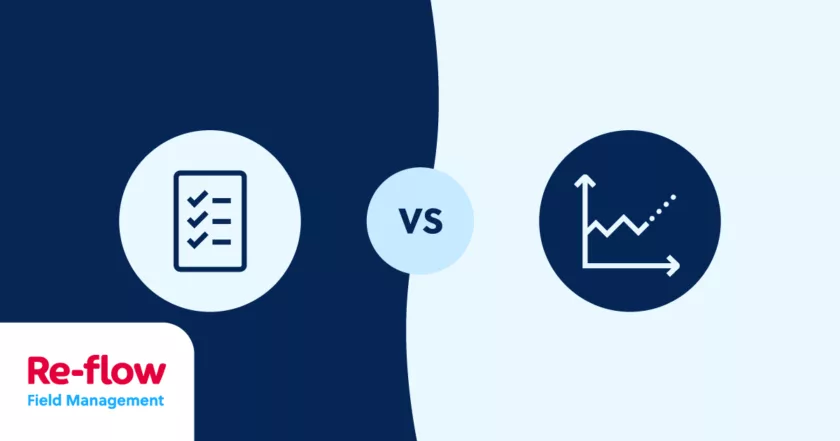
News
How to balance efficiency and productivity?
Businesses in field-based industries face a whirlwind of operational processes. Appropriate allocation of resources and labour is key to ensuring efficiency and productivity on-site, but what’s the difference between the two, and how do you strike the right balance?
Efficiency
Productivity
Measuring efficiency and productivity
Productivity
Productivity can be quite abstract and tends to be influenced by a variety of outside factors beyond the control of a business, such as the state of the economy and competitors. Nonetheless, obtaining an estimate can help managers appropriately allocate resources and plan ahead. The basic formula for productivity is the following:
Productivity = Total Output / Total Input
Returning to the surfacing example, two teams - A and B - are set a target of surfacing 20 miles of road over a 40-hour work week. Team A meets the target, achieving a productivity of 0.5 miles surfaced per hour. The input here would be 40 hours, while the output is the 20 miles that have been surfaced.
0.5 Miles Surfaced per Hour = 40 / 20
Team B, on the other hand, surpasses the target and surfaces 25 miles in the same amount of time. Using the calculation once more, this yields a productivity of 0.6 miles surfaced per hour – 20% higher than Team A.
0.6 Miles Surfaced per Hour = 40 / 25
Although this productivity formula is a simplistic measure, it does provide value in helping measure the performance of individual operatives or teams in terms of quantity.
Efficiency
If productivity is about maximising the amount of work product, then efficiency measures the quality of that work product. To do this, you need a standard to measure it against. With that, you can measure efficiency using the formula:
Efficiency = (Standard Labour Hours / Amount of Time Worked) * 100
If only productivity is measured, Team B outperformed Team A. Yet, when assessing the quality of the work, several faults in Team B’s work are identified. These require rectification which takes two additional working days, adding on 16 hours to the amount of time worked. Following the formula, this would yield an efficiency of 71%.
71% = (40 / 56) * 100
Team A’s work, on the other hand has no faults. Despite the higher productivity of Team B, the additional cost of rectifying their faults results in a lower level of 71% efficiency compared to Team A’s 100% efficiency, despite their lower productivity.
Balancing Efficiency and Productivity
The right balance between productivity and efficiency needs to be determined on a case-by-case basis by companies, be they in highways, rail, construction, or civils. Every sector has it’s own processes and expectations, meaning a “one size fits all” approach is simply impossible.
When balancing these two elements, it’s important not to view it as sacrificing productivity for efficiency or vice versa. Poor efficiency doesn’t necessarily equate to great productivity, in fact it’s quite the opposite. If teams are spending a significant amount of time re-doing rushed, poor-quality work, resources are being siphoned away from other projects, and productivity suffers as a result. In extreme cases, this can come at the cost of clients and contracts, which has a direct effect on staff morale and employee retention.
That’s why optimising your company’s operational processes to improve efficiency is crucial to achieving sustainable business growth. Many businesses are now trading paperwork systems and fragmented spreadsheet software for more comprehensive, digital field management solutions. With a more efficient foundation that streamlines many repetitive administrative processes, teams on all sides of the business can benefit from more time, where productivity can increase as well.

For example, the construction company, MWBenney, traded their manual processes for Re-flow’s field management software for construction. This led to a reported 90% increase in time saved, a 50% increase in cross-team communication and a 40% reduction in paper. These improvements meant operatives and office staff could do more in the same amount of time, paving the way to increased productivity across the business.
The main way field management software increases productivity is by automating repetitive admin tasks and streamlining workflows. Rather than physically transporting job packs, forms and communications to remote sites, instant communication between the dashboard and app components of the system allows users to receive all necessary work information through their mobile device. With digital form completion through said app, automated workflows can be triggered based on submitted data. This means actions such as recording vehicle defects or scheduling servicing no longer need to be done by a staff member, enabling resources to be diverted elsewhere.
Meanwhile, efficiency is also improved. Asset management ensures that equipment is serviceable, workers are properly qualified to carry out work, and materials are being properly accounted for and stocked as needed. Enabling compliance through forms helps reduce errors in reporting. This, coupled with evidencing work through capture, sign-off, and tracking ensures work is completed to standard. All this feeds into live data reports, facilitating forward planning and data-driven decisions that help to measure and improve efficiencies across the business.
The Human Cost
The benefits of balancing productivity and efficiency are more than just financial. Declines in worker safety along with adverse environmental impacts are both consequences of neglecting efficiency in favour of raw productivity.
It’s natural to cut corners when put under pressure with tight deadlines and high productivity quotas. Despite that, it’s not a position any worker should feel forced into. For example, earlier this year, a rail company was fined over half a million pounds for taking shortcuts in their HSE management, which would leave the affected operative permanently unable to work.
Ultimately, the responsibility to ensure that safety and efficiency are not compromised in favour of productivity rests with the companies, not the workers. The steps need to be taken to ensure that HSE standards are maintained and that workers are complying with the correct working practices.
Environmental Benefits
With the government’s aims to achieve net-zero emissions by 2050, heavy industry sectors such as construction, civil engineering and rail will carry a heavy burden to reduce their carbon footprints. While the bulk of this is intended to be achieved through the adoption of green technologies, new energy sources and more sustainable working practices, improving workplace efficiency will also play an important role. Ensuring resources are being allocated as optimally as possible, and workers are achieving more with their time can go a long way in building a framework for sustainable business growth.
The Takeaway
To put it simply, productivity is the measure of the quantity of work done, while efficiency measures the quality of said work. While it certainly varies between sectors, and even individual businesses, it’s crucial to find a healthy balance between the two. Neglecting one in favour of the other can have serious consequences beyond missed deadlines and reduced profitability. The human and environmental ramifications must be considered at all times, and operatives should never be forced to make tough decisions to meet unrealistic productivity or efficiency targets. Luckily, the increased adoption of new technologies is offering an accessible way for businesses to find that healthy balance and grow sustainably.




